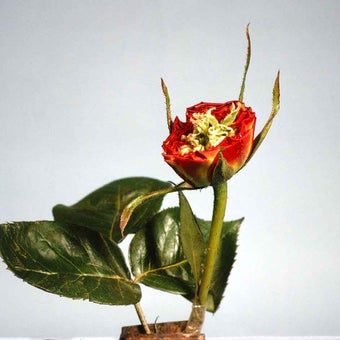
Quick facts
Common name - Phyllody
Plants affected - Many, particularly strawberry, roses, clover, plants in the Asteraceae family
Main causes - Various conditions affecting flower development
Timing - Mostly spring and early summer
Symptoms/Appearance
Plants bear symptoms of phyllody when;
- The entire flower is replaced with leafy structures
- Leafy structures arise from a malformed flower
- In strawberries leafy structures develop from the seed-like achenes on the surface of what is regarded as a ‘fruit’, which is essentially the swollen top of the flower stalk
Similar looking problems
Other abnormal growth that can look similar to phyllody include;
Flower proliferation - another flower, or group of flowers grow from, or around, the initial flower.
Fasciation – production of flattened shoots that may appear to be composed of several fused shoots and/or flattened elongated or misshapen flower heads with numerous flowers.
Other mutations – often described as a sport or a break, that result in a sudden change in the appearance of a part of a plant such as flower colour and form, foliage or fruit or growing habit. This usually affects only some parts of the plant.
Causes of phyllody
Environmental: Factors such as late frost, hot weather or water stress during flower development can cause hormonal imbalances resulting in phyllody. Environmentally-induced phyllody does not usually affect all flowers.
Control: If the cause is environmental, the plant will produce normal flowers later in the or during the following season. Some plants such as roses, clovers, asters and strawberries seem to be particularly susceptible. Remove the affected flowers, if desired. If practical, protect from cold damage, e.g. with fleece, and prevent drought stress.
Disease: Phyllody can be a symptom of phytoplasma infection. Phytoplamas are bacteria-like parasites that grow and multiply in the vascular tissue of plants. They are usually spread from plant to plant by plant-sucking insects such as leafhoppers and mites.
Control: Once infected with a phytoplasma, plants will always produce distorted flowers. There is no cure and plants are best destroyed. Control insect pests to prevent spread of the infection. Do not propagate from infected plants. Keep pruning and propagation tools clean.
Weedkiller damage: Weedkiller contamination can also cause abnormal growth. Accidental contamination from spray drifts, accumulation of weedkillers in or , or over application of path/drive weedkillers close to borders.
Control: Depending on the severity of damage, affected plants often recover, but it may take time. See manure and weedkiller contamination for more information.
Phyllody in strawberries
One of the plants that commonly shows signs of phyllody is the strawberry. The ‘fruit’ we eat is derived from the receptacle (the swollen tip of the flower stalk), and the true fruits are the tiny, seed-like achenes on the surface.
When a strawberry is infected, the seed-like achenes on the fruit start producing leafy growth.
Causes of phyllody in strawberries
Disease: Phytoplasma infection – see above.
Weedkiller damage: Accidental weedkiller contamination - see above.
Overfeeding: Heavy application of foliar feed can stimulate abnormal growth.
Control: Avoid overfeeding.
Collecting strawberry runners during warm autumn weather for cold storage: Commercially, runners are collected in the autumn and stored at -1°C for distribution and planting in spring. It is thought that unseasonably warm temperatures during initiation in the autumn causes cells in the developing bud to be pre-disposed to leafy growth rather than fruit development and a number of fruits can develop phyllody during the first year of growth.
Control: Remove affected fruit. Temperature-induced phyllody only affects the fruit in the first year after planting. Occasionally it only occurs on early ‘fruits’ with later showing normal crop.
‘ fail’: This has been reported in the variety ‘Malwina’. This causes a large number of fruits to suffer from phyllody; sometimes the entire crop during the plants’ first year. This does not require cold storage or warm autumn weather to trigger the condition.
Control: Remove all fruit if the ripening fruit starts showing the symptoms. If caused by ‘genetic fail’ phyllody does not occur on these plants in subsequent years.




